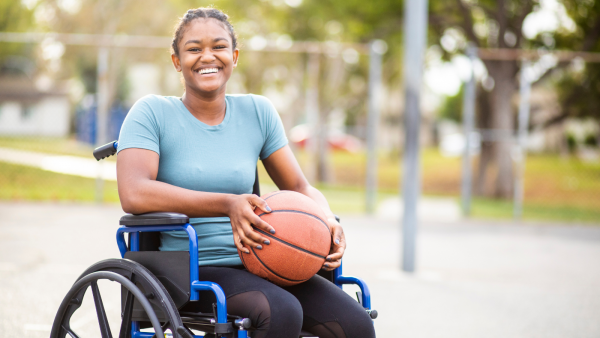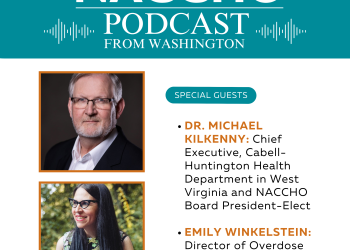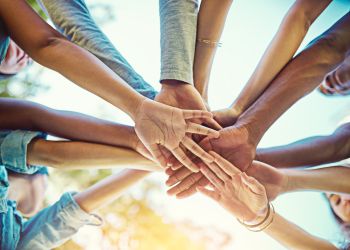This blog post was written by Joseline Raja-Vora, Health and Disability Fellow at NACCHO. Joseline is a graduate student pursuing a PhD in Kinesiology (Focus: Adapted Physical Activity), and an MPH in Health Promotion and Health Behavior at Oregon State University.
Physical activity is good for everyone
Physical activity plays an important role in improving quality of life for people of all ages. The benefits of regular exercise and physical activity are well known. Exercise is very effective in maintaining a healthy weight, improving muscle strength, preventing health conditions like diabetes, stroke and high blood pressure, while improving cognitive functioning, sleep and overall energy. Exercise has also shown to reduce feelings of depression and is a means to socialize with others.
Physical activity guidelines are not met
Although many are familiar with the benefits of regular physical activity, the U.S. Department of Health and Human Services reports that only 1 in every 4 adults in the United States meets the physical activity guidelines developed by the department. The recommended amount of physical activity for adults is at least 150 minutes of moderate-intensity or 75 minutes of vigorous intensity of exercise every week. Among people with disabilities, lesser than 15% adults meet these guidelines.
The COVID-19 pandemic posed additional challenges to being physically active. With fitness and recreation centers being closed or limiting clients, maintaining a physically active lifestyle has been especially tough for people with disabilities. Many fitness centers have started online classes to allow greater flexibility during these times. However, there is still a dearth of both in-person and online workout options for people with disabilities.
Local health departments being a champion of the community’s health needs can intervene in simple ways to get their community, especially the more vulnerable individuals to be active despite the various barriers that the pandemic has brought about.
How can local health departments promote physical activity for people with disabilities during the pandemic?
Some simple ways in which local health departments (LHDs) can support people with disabilities to be active during the pandemic:
- Representation from the community - Give a voice to community members! LHDs should identify needs and challenges faced by people with disabilities during the pandemic. Empowering them as an integral part of planning and steering committees can be one way to engage the community.
- Form sustained partnerships - There are several universities and fitness centers around the country that have specialized fitness programs for people with disabilities. As these programs are designed specifically for people with disabilities there will be lower enrollment as compared to other fitness facilities in the community, thereby ensuring safe workout environments for people with disabilities during the pandemic. Partnering with such programs would also provide more opportunities for individual attention, thereby greater likelihood in enhancing competence in physical activity for people with disabilities.
- Have accessible websites with easy-to-follow exercises - These websites could use universal design wherein people with and without disabilities can benefit from the exercises. Having a step-by-step breakdown of each exercise, accompanied by pictures, audio and video descriptions of each step will be most beneficial for people with and without disabilities.
- Promote guided outdoor activities - As there is relatively lesser risk of spreading the coronavirus in the outdoors, health departments should initiate guided small-group sessions for activities like walking, rolling, kayaking, hiking, camping and gardening. The guided sessions can introduce people with disabilities to new activities that can be sustained independently after a few guided sessions. Health departments can partner with the local parks and recreation departments or connect with the National Recreation and Park Association (NRPA) to plan and propagate these activities.
- Ensure accessibility of outdoor spaces - With increased outdoor activities, it’s also essential to ensure that these outdoor spaces are and remain accessible. For example, dirt roads or ill-maintained roads are difficult for a person using a wheelchair to navigate on. In advertising about opportunities to engage in PA outdoors, health departments can emphasize the inclusive nature of all activities, even including pictures of people with disabilities on their brochures/websites.
- Provide DIY options to exercise from home - From using laundry detergents as a substitute for kettlebells to doing glute bridges with the support of a couch, simple household objects can be used effectively as exercise equipment. Providing these resources in demo videos or handouts may be beneficial for people with and without disabilities.
- Building a virtual community - Physical activity is a great way to socialize with others. Having companionship while engaging in physical activity makes the activity more fun than merely a task. Health departments can make virtual/social media groups to build virtual communities of shared interests. Some examples can be state/county-specific walking groups, yoga enthusiasts, hikers, dog walking groups.
The pandemic may be transitory, but it can leave long-lasting effects on the health and well-being of the community. Health departments have the ability to nudge their communities in the direction of a healthier lifestyle during and after the pandemic.
Resources:
Physical activity resources for health professionals/health departments
- CDC Resources on Increasing Physical Activity Among Adults with Disabilities: https://www.cdc.gov/ncbddd/disabilityandhealth/pa.html
- https://www.nrpa.org/contentassets/adf76d09aef54240b4eb449ce6111b96/parksforinclusion-disability.pdf
Workouts at home/self-driven workouts




